Rural Life and Tragedy
When TLM-P wrote his memoir about his voyage to Australia, he commented that he was too ill to work outside, 'almost the first time after sixty years of robust health'. That good health until he was 60 years old, and his need for physical activity outside, was a major influence on his life in Australia. The timing of his arrival in the colony was one of mixed blessings. On one hand, a drought during 1838-39 contributed to a severe economic depression in the 1840s. TLM-P's fellow passenger, the Rev. W. Clarke, provides us with a glimpse of the difficulties when he wrote in August 1841:'The whole colony is in a state of distress … There is scarcely one man in a thousand who can pay his way, even public men [government employees] are unpaid … We are all nearly ruined together.' The rural districts, as Elena Grainger writes, had 'the reek of boiling-down works pervading the air as graziers melted down the fat from the meat from heir sheep rather than give them away for wool or mutton, or, worse, allow the tortured ewes to nudge their still-born lambs until they too died of thirst.' 1) On the plus side, there was an acute shortage of healthy young men like TLM-P, especially from 1840 after the colonists successfully ended convict transportation to NSW. Additionally, like so many other successful squatters, TLM-P enjoyed hard physical work and maintained a hands-on approach even when he had become wealthy.
TLM-P was too late to benefit from free land grants, but he did benefit from the increasing privatisation of the land in what is now Queensland. When the Moreton Bay penal settlement closed in 1842, three years after TLM-P arrived in Australia, the area was opened to free settlement. Such settlement was first through yearly depasturing licences (which allowed squatters to graze stock on Crown lands beyond the limits of location). After the 1847 Land Act made it possible to buy land,2) settlers could purchase land freehold.3)
In 1860, a year after Queensland became a separate colony, four Lands Acts of 1860 were passed relating to the settlement and
alienation of Crown lands. These leases were for 14 years and enthusiastically taken up.4) One provision was for 'squatting licences … a sort of trial of the squatter prior to granting him a lease over his run. If he failed to stock the land for which he had obtained a licence within nine months, he became ineligible to claim a lease and the land was forfeit.' For more on the complexities of colonial land ownership, and the huge benefits reaped by squatters acquiring Crown/indigenous land, see Beverley Kingston, 'The Origins of Queensland's “Comprehensive” Land Policy', Queensland Heritage, 1:2, 1965.5)
Dalwood
The first thing TLM-P needed was to gain colonial experience, a form of internship to learn the ways of the colony. He did so on a property called Dalwood, near Maitland in the Hunter Valley, north of Sydney.6) Dalwood House (pictured) 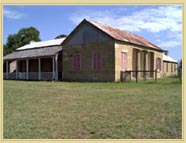 is now a National Trust Property, located within the Wyndham Estate Winery.7) In 1839 Dalwood was owned by George Wyndham and, luckily, some of his family letters have survived.
is now a National Trust Property, located within the Wyndham Estate Winery.7) In 1839 Dalwood was owned by George Wyndham and, luckily, some of his family letters have survived.
How and why did TLM-P end up at Dalwood? The chance preservation of a letter in the Wyndham collection tells us. It was due to the strong network of the military men who fought in the long war against Napoleon8) and a chance encounter. On 22 December 1838, George Wyndham's Great-Uncle William wrote to him from England to say that he had had a letter from a friend Arthur Heathcote:
'to say a friend of his (or rather his son) is about to sail in a few days for Sydney to seek his fortune. It is Mr. Prior, a young man Heathcote speaks well of, a son of, I believe, a brother-officer of his and one who fought on the plain of Waterloo. I met the young man at Farnborough Castle Fair with Heathcote, who has given up the Army …[and lives nearby]. I do not know for certain what line the young man intends to follow, but have no doubt it is that of farming. If you can show him any kindness in the way of hospitality, etc., I shall be much obliged to you. It is now become so fashionable [to make] a trip to your new country that I think your hospitality will be heavily taxed ere long, but I should fancy that any face fresh from home must be very welcome.'9)
Another connection was Brussels. In the 1820s, George Wyndham's father-in-law had run 'a school for English boys in Brussels'.10) It is not known if this was the school associated with the Rev. Drury that TLM-P had attended, or another one. In any case, TLM-P was lucky as George Wyndham was generally admired: 'Respected for his leniency to his assigned labour in the early days and himself a hard worker in the field, George Wyndham considered himself mainly a farmer and pastoralist. He was highly respected within both the local and wider community.'11) Evidence that TLM-P established an enduring relationship with the Wyndhams comes from his photo album. It includes a photo of Reginald and Julia Wyndham, George and Margaret's son and daughter-in-law, taken in 1868, and two of John Wyndham (another of George's 11 sons?) taken in 1869.
While we are lucky to have the above pieces of the jigsaw, luck runs out with George Wyndham's diary for 1830-4012): it is brief and largely focused on the weather - sadly, it makes no reference to TLM-P.
Belford
TLM-P then gained more colonial experience at Belford, another Hunter Valley property, and owned by Robert Dawson13) and Mr Samuda.14) Photographs from his album indicate that he also kept in touch with the Dawsons, so he was lucky in finding compatible employers. Note that Patricia Clarke says that the property he worked on, owned by Robert Dawson in the upper Hunter, was called Goorangoola.15)
TO DO insert photos of Dawsons from TLM-Ps album.
Rocky Creek
Having gained some colonial experience, the 21-year old TLM-P was appointed manager of Rocky Creek Station in the Northern Tablelands of NSW, south-east of what is now the town of Moree.16) The station was/is on Rocky Creek, which flows into the Horton River, which in turn flows into the Gwydir River in the Nandewar Ranges.17)
 A contemporary view of Rocky Street Station by artist Mick Pospischil.
A contemporary view of Rocky Street Station by artist Mick Pospischil.
The station was owned firstly by John Harley Pagan until his death in May 1846, aged 32; then by Robert Pringle.18) Colin Roderick, in his biography of TLM-P's daughter Rosa, states that Jacob Low, the Head Stockman at the time, had worked as a clerk in Edinburgh and was a friend of TLM-P. However, there is no information whether the friendship caused TLM-P to go to the station, or was a result of their work together there. Roderick also states that TLM-P stayed at Rocky Creek for two years. It was during this time that he made trips to Sydney, stopping on the way at Cecil Plains, a station owned by the Harpurs: the attraction was young Matilda Harpur, his future wife.19)
It was also at Rocky Creek Station that TLM-P formed a friendship with the celebrated explorer Ludwig Leichhardt.20) He later recollected that 'poor Leichhardt [went] with me on my road to take possession of my first station, Rosewood'21). Leichhardt and TLM-P both needed the protection of extra men as they had to travel through land heavily defended by its Aboriginal owners.22) For more on TLM-P's friendship with the German explorer, click on Leichhardt.
Rocky Street Station was a testing place for a young, relatively inexperienced manager. It was at the centre of violent conflict between the settlers and the indigenous owners: there had been an Aboriginal attack on nearby Terry Hie Hie station with the revenge massacre of hundreds of Aboriginal people at Waterloo Creek. It was also in the vicinity of Myall Creek station where, in 1838, armed stockmen and a squatter's son murdered 28 defenceless Aboriginal people. Myall Creek had led to widespread white outrage when the attackers, other than the leader, faced criminal charges and some were hung.23)
Rosewood
While he would later reminiscence about the sacrifice his mother had to make to give him a few sovereigns, in 1843, four years after his arrival in the colony, he thought he had saved enough capital to become a squatter and stock a property: Rosewood at Moreton Bay (between present day Ipswich and Laidley, located 'at the junction of Lockyer and Laidley Creeks'.24) Rosewood had been owned by Dr John Goodwin (c1800-59)25) but land records indicate that TLM-P bought the lease, presumably from Dr Goodwin.26)
As Patricia Clarke points out, TLM-P stuck out on his own in largely uncharted country for Europeans, 'just three years after Patrick Leslie and his brothers had begun the wave of squatter settlement on the Darling Downs'.27) It appears that TLM-P was overly optimistic about the capital needed to run a station, as he soon left Rosewood. When he wrote to the Ludwig Leichhardt in September 1843, he mentioned that he intended 'selling my station and believe I have already got a purchaser'. He had stocked it with sheep and horses.28) TLM-P still, however, saw opportunity to the north of what was then the colony of NSW. From his time at Rosewood onwards, TLM-P had his home in what became, from 6 June 1859, the colony of Queensland. When TLM-P first arrived, it was very much a frontier settlement attracting settlers like him with military experience. Moreton Bay had just ceased to be a penal colony leaving a significant proportion of the small white population 'unfree'. It is estimated that 15 per cent of the population of County of Stanley (which included the major centres of Brisbane and Ipswich) in 1846 was in this category.29)
To do: An account book for Rosewood, Lockiers Creek, for 1843 was donated to ML with TLM-P's diaries.
TLM-P needed to be reasonably self-sufficient. That included not only medical books but also at least one on the law.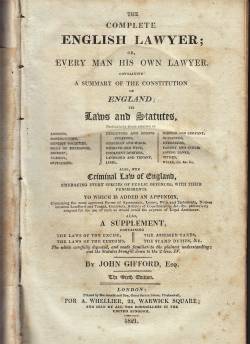 This book30) is inscribed,
This book30) is inscribed,
'Thomas Lodge Murray Prior
Logan River Moreton Bay.
January 1845'.
Broomelton/Bromelton/Bungroopin
Armed with his book on English law, TLM-P went into partnership to lease his second property on 24 September 1845. His partner, Hugh Henry Robertson Aikman, had occupied Broomelton since July 1842 when he was granted what is believed to be the first license to depasture [i.e. graze cattle on] Crown Lands on the banks of the Logan River.31) TLM-P solved the problem of inadequate capital by borrowing from his half-sisters: £600 in several instalments.32)
Broomelton (as it was originally spelt on the property documents, after an Aikman property in Scotland) was on the Logan River, 35 miles from Brisbane, near the current town of Beaudesert. The M-Ps spelt it Bromelton. Isobel Hannah describes Bromelton as being 'watered by the Logan River, part of Teviot Brook, Allen's Creek, and Crow's Creek.' 33) The property was also known by the Aboriginal name of its nearby lagoon, Bungroopin (now rendered Bungropin) meaning 'the place of parrots'.34). The NSW Government Gazette listed Bromelton on 30 September 1848 as being 60 square miles (15,54 hectares).35)
TLM-P was now sufficiently established to marry his love, 18-year old Matilda Harpur, who subsequently joined him on the isolated property. She was idealistically keen to prove her mettle as a pioneer wife. A letter of hers quoted by Colin Roderick36) has her chiding him for selling his bullocks so that he could employ builders to erect a suitable house for his young bride: 'Let me beg of you to make no such sacrifice again, but to discharge those builders, and when I come, let me be your assistant in improving your hut, for indeed I should like to have in my power to prove that I could be happy with you anywhere.' Hopefully, TLM-P continuing with the building though, even so it is probable that Matilda went to a 'slab hut'.37) The description comes from Rosa Praed who wrote about that 'slab hut' in her Australian Life, Black and White, but it should be kept in mind that she was first and foremost a novelist, and that she left Bromelton when she was 2 years old. While she drew on other family members' memories, decades had passed and they had had numerous homes by the time Rosa wrote her memoirs.
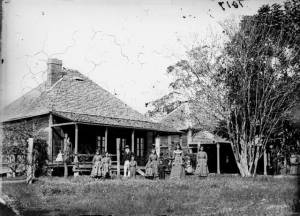 Bromleton homestead in 1872: it was later demolished and another home built on the site.38)
Bromleton homestead in 1872: it was later demolished and another home built on the site.38) 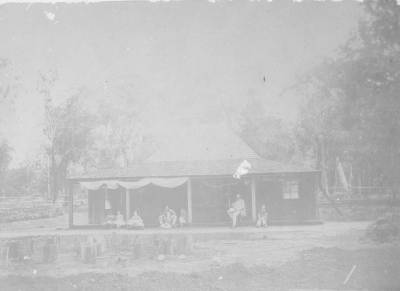 Is this faded photo Bromelton? It is reputed to be one of the family homes, though it is odd that Matilda doesn't appear, and what was the occasion that merited the man on the right (TLM-P?) formally dressing complete with top hat? If the boy on the right is T de M. M-P, and the photo of Bromelton, then it was taken towards the end of their time there.39)
Is this faded photo Bromelton? It is reputed to be one of the family homes, though it is odd that Matilda doesn't appear, and what was the occasion that merited the man on the right (TLM-P?) formally dressing complete with top hat? If the boy on the right is T de M. M-P, and the photo of Bromelton, then it was taken towards the end of their time there.39)
When Aikman inherited his brother's estate in Scotland, TLM-P bought out his partner's share of Bromelton.40) While Australia's Representative Men states he bought out his partner in 1853 this is likely a mistake and it was actually 1850, with the process starting a year earlier when Aikman returned to Scotland.41) The partnership appears to have been a happy one. When TLM-P was in England in 1882, he received a 'nice' letter from Aikman's son saying his father had died, 'that he had often heard him talking of me and … looked upon his Australian life as the happiest' and inviting him to visit if he was in the locality.42)
Colin Roderick concluded that TLM-P' time at Bromelton was essentially a failure. When sheep failed to thrive, he tried a 'boiling-down establishment' - boiling animal carcasses for tallow and other by-products, but that proved unprofitable.43) Live cattle were profitable, but decreasingly so.44)
Further information is gleaned from the (not necessarily accurate) Annual Returns of Depasturing. The return for 30 June 1851 states that the property was 60 square miles (15,539.9 hectares) and carried 6 horses and 2,200 cattle. The annual licence fee was £31. A year later, the run had expanded to 98 square miles (25,381.9 hectares) and had 7 horses and 2,120 cattle, while the license fee had increased to £41. Three years after Aikman left, on 30 June 1853, TLM-P reported that the property was 19,200 acres (7,770 hectares) and that the cattle had gone, replaced with 4,000 sheep and, strangely, no horses. The annual licence fee was reduced to £10/2/0. As Patricia Savage comments, this was 'before it was fully realised that sheep don't exactly thrive on coastal Queensland'. (Colin Roderick claimed that 'Fluke, foot-rot and scab' all infected TLM-P's sheep). We will probably never know the real story behind these annual fluctuations, but it is a reminder that much of the squatters' early efforts were trial and error, due both to their own limited background in agriculture and ignorance of their new country.45) TLM-P was not the only Britisher to assume sheep would thrive in what is now seen as cattle country: Robert Cambell owned Maroon in 1846-50, and estimated that it could carry 5,000 sheep.46)
More information about TLM-P's early difficulties at Bromelton come from his letters to Matilda before their marriage in September 1846. According to Rosa Praed who apparently was given the letters, he complained of difficulties keeping his working horses shod and in good condition; of the large number of travellers that he (and all settlers) where expected to feed and house; the expense and labour entailed in sending rations to workers on distant parts of the property; and worry about 'myall Blacks', that is, those who tried to adhere to their traditional lifestyle and were considered, in the language of the time, to be 'wild'. He also wrote to his intended that his major worry was saving £200 47), the amount he considered necessary for married life. 48) Floods and distance were also problems. Rosa cited Matilda writing that it could take 12 weeks for supply drays to arrive from Brisbane, and during floods they drays had to wait until the river subsided. Despite all the difficulties, Rosa claimed that her mother wrote to Eliza M-P, her mother-in-law, that 'Some day this will be a flourishing country; its capabilities are greater than any of us know, and our descendants may be building towns on this wild land which we have reclaimed from the wilderness.'49)
To assist in his financial difficulties, TLM-P sold 20,000 of Bromelton's original 38,400 acre lease. Finally, in 1853 or 1854, he sold the rest of the leased land.50) in September 1853.51) Isobel Hannah states that it was sold (without stock) for £2,500 (roughly equivalent to $253,405 in 2017).52) The relative failure of this enterprise could only have been a blow. He had his young wife and the inevitable growing family to support; not only that, but he had borrowed £600 from his step-sisters who, as Victorian 'ladies', had virtually no employment options that did not entail drudgery and a severe loss of status for the whole family. In 1850, £600 in 2017 values was approximately $79,177, so it was no small matter for either of the parties. Despite all the difficulties, Rosa claimed that Matilda wrote to Eliza M-P, her mother-in-law, that 'Some day this will be a flourishing country; its capabilities are greater than any of us know, and our descendants may be building towns on this wild land which we have reclaimed from the wilderness.'53)
Among the diaries donated to ML was a 13-page ledger for May 1848 to 1849 for this station.54)
A Memoir of Bromleton and Hawkwood
More about TLM-P and his properties can be found in reminiscence of Ernest Davies55), who acquired his colonial experience as a jackeroo for TLM-P. His brother Henry had migrated a 'couple of years' earlier than Ernest and was the manager of TLM-P's new property, Hawkwood. There is no information how the Davies brothers and TLM-P met, but one connection was Belgium. Davies was born at Ostend in Belguim in 1836, which may have resulted in mutual acquaintances. He migrated to Australia in around 1855, and met TLM-P in Sydney shortly afterwards. He recalled that, aside from Bromelton, TLM-P owned a property called Woogaroo 'halfway up the river between Brisbane and Ipswich' as well as 'considerable … land on the Brisbane River' in an area called the Pocket. Davies describes how, at Bromelton, TLM-P had been 'for some years been building up a fine herd of short-horned Durham cattle and importing thorough-bred bulls from England.' He kept this stud herd safe near his town home on the Brisbane River. By the time TLM-P employed Davies, he had sold Bromelton with one provision being that the buyers would deliver 'certain drafts of cattle year by year for a stated period in payment for the station and stock'. Ernest Davies' first task was to assist in the delivery of 'some 300 or 400'56) stock from Bromleton to TLM-P's new station 'Hawkwood', where his brother was 'then in charge'. Ernest Davies worked for some years for TLM-P, noting that 'eventually for a year of so [he] took charge of Hawkwood when Mr. Prior was away.'
Davies described Bromleton as having a 'very nice garden' next to a large, deep lagoon. The lagoon covered at least 2.5 hectares. It was the age where much of the native fauna was new, and TLM-P and Matilda's sister Elizabeth both were convinced that they had seen the water creature the Aborigines believed inhabited the lagoon: a bunyip. TLM-P was so convinced that he wrote to the Moreton Bay Courier reporting the sighting of 'an aquatic monster'. It was a claim that meet with ridicule - at least amongst white Australians, not so indigenous ones. Later accounts suggest that what they (and others) fleetingly saw was likely to have been a crocodile.57)
Chinese Indentured Labourers
Maxine Darnell has compiled a list of Chinese labourers who she has identified as having been brought to Australia to work on a fixed contract. She points out that only a minority of these men have been identified. Court records account for an over-representation of men who fell foul of the legal system. Her list is at indentured.pdf. TLM-P is given as the employer of 19 Chinese men between December 1848 and May 1857 at Bugrooperia and Hawkwood. For details, click on Darnell list. TLM-P's employment of these men is in keeping with his - and the squatter faction generally - desire for cheap labour, including his support for the renewal of the transportation of convicts.58)
Land dealing and selections in and around Brisbane
Despite TLM-P's problems with Bromelton, Helen Gregory found that, during 1852-54, he spent just over £1,364 on land in and around Brisbane. That sum was around $92,619 in 2017 values. 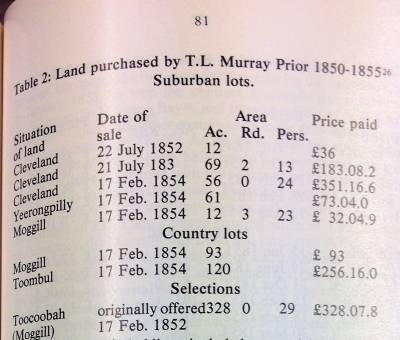 59)
59)
The last selection at Toocoohah (Moggill) became known as Prior's Pocket. Helen Gregory outlines how TLM-P had a house 'across the river at Woogaroo' (later called Goodna, now an outer eastern suburb of Ipswich) and used the peninsula Prior's Pocket to fatten his 'imported herd of short-horned Durham cattle'.60)
Hawkwood and massacres
By 1854, TLM-P decided that he had to look north for opportunities. He sold the lease to Bromelto and, as shown, bought considerable land in and around Brisbane61). Also in 1854, he applied to select 640 acres on the west bank of the Albert River.62) His most significant acquisition was a property called Hawkwood (its indigenous owners called it Naraigin) on the Auburn River, a tributary of the Burnett river (north of what is now the Sunshine Coast). The Hawkwood venture started ominously. One source states that, when moving his sheep to his new property, they became infected with scab63) with the result that he had to destroy 8,000 of them.64) The family initially moved from Bromelton to Woogaroo on the south bank of the Brisbane River, while he put his stock on a 'narrow neck of land opposite, then called the Pocket, now known as Prior's Pocket'. He helped stockman overland sheep and cattle to Hawkwood, then moved his family there early in 1856.65)
For TLM-P and his growing family, living conditions at Hawkwood were primitive. Rosa Praed's reminiscences always need to be read with caution, and she left Hawkwood when she was 7 years old, but described their home as a hut made of wooden slabs with gaps between them, windows without glass and mostly earthen floors. She recalled that, in this primitive dwelling, TLM-P hung his collection of paintings which were later donated to the Queensland Art Gallery.66) The four years they stayed at Hawkwood were marked by 'great anxiety and hard work'.67)
Hawkwood was relatively isolated and the 1850s was a time of bitter war between the white settlers and the Aboriginal people who had lived there for some 50,000 years. A flashpoint occurred in 1857, in what is now known as the Hornet Bank massacre. The definitive research into this massacre is a Masters thesis and subsequent book by Gordon Reid.68) A succinct summary is at Colonial massacres - Hornet Bank aftermath. The Hornet Bank massacre was the murder of eleven of the Fraser family and staff who lived on Hornet Bank station; the women were also raped. The murders were by Yiman (variously Jiman or Iman) language group as well as some men who had belonged to the notorious Native Police. The massacre was reputedly in retaliation not just for the seizure of Aboriginal land, but also for the rape of Jiman women by the young men of the Fraser family - which took place despite the pleas of their widowed mother.
One of the most unusual things about this massacre is that its aftermath was recorded: it was just one of the ways that TLM-P supported his daughter's Rosa Praed's desire for Australian material for her novels.69) When he dictated his memory of this time to his wife Nora to send to Rosa,70) TLM-P stated that he believed that the Hornet Bank murders were part of an Aboriginal conspiracy to exterminate the whites. Other settler families were threatened when there was a gathering of Aboriginal people some six weeks after the Hornet Bank tragedy. Hawkwood employed three unnamed Aboriginal men and one woman (from the coast, not from the local area), as well as Ernest Davies, Sydney Ling, a German doctor, and' one or two others'. They had 'plenty of arms and ammunition'.71) TLM-P states that a group decided on a preemptive strike against the local Aboriginal people. Leaving shearing to others, a vigilante troop of 13 or 14, including TLM-P and two of his Aboriginal employees, set off. He claimed that the Aboriginal men in the party wanted to kill women and children as well, but he prevented that by stating he would withdraw the Hawkwood group if he saw any woman or child hurt. In his reminiscences, Ernest Davies stated that in their six-week 'hunting' expedition, in the name of 'rough justice', they killed as many men of the Upper Dawson 'tribes' as they could.72) According to TLM-P, 'The war was kept up for 18 months, during which there were continually one or two parties out, and gradually a good many of the ringleaders were accounted for [killed] … These 18 months of warfare were an anxious time for us. Business often took me then a good deal from the station. When I came home I used to canter pretty sharply to the top of the ridge from which the place was visible with my heart in my mouth, for there was always the fear that all hands might have been massacred.'73). For sample pages of TLM-P's description of the massacre, click on Hornet Bank.
TLM-P and the rest of the vigilante group returned to their properties after the Redbank murders.74) Eventually, their actions are believed to have resulted in the deaths of some 150 Aboriginal people: some 80 shot by the original vigilante group; 70 by the Native Police. Later retaliations are thought to have added another 150 to the overall number killed. Queensland at the time was very much a frontier settlement, with minimal consequences for taking Aboriginal lives.75) Going to a magistrate would have been of little use: TLM-P was not only a magistrate, he and three other magistrates wrote to the Colonial Secretary demanding harsher penalties for Aboriginal resistance.76) In his memoirs, TLM-P shared the common view that it was reasonable that William Fraser, who had survived the massacre of his family, embarked on a lifetime of indiscriminate killing of Aboriginal people. William Fraser became a folk hero among whites despite being 'one of the greatest mass murderers in Australian history'.77) He subsequently died of old age without facing prosecution.
Information about the Hornet Bank massacre has been complicated not only by an unwillingness to acknowledge that it was a result of a war between white and black for the possession of land, but also by the unreliable memory of Rosa Praed when later writing Australian Life: Black and White, London, 1885 and My Australian Girlhood, London, 1904. As Reid (pp.iv,77) comments, Rosa was a novelist rather than an accurate memoirist. As well, Rosa was only 7 years old when she left Hawkwood, and she wrote about that time 27 years later.
TLM-P sold Hawkwood in the year after the Hornet Bank massacre. The property had not been a financial or any other success. It appears the final straw was another outbreak of scab among his sheep. The family was apparently popular with his neighbours as they are said to have gifted him some 900 sheep to help replenish his flock.78) For TLM-P's next venture, he tried to leave behind the problems of livestock.
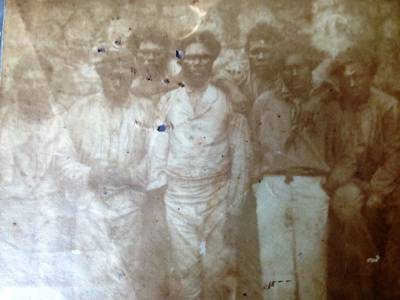 This photo of a group of Aboriginal workers (stockmen?) in the Murray-Prior papers (ML PXB661) has no attached information. It is a reminder of the huge gaps in our knowledge about the past, not the least in 19th century history from the Aboriginal viewpoint. The photo, faded and damaged as it is, gives context to TLM-P's poor opinion of depictions of 'Australians' and other indigenous groups at the Crystal Palace in England in 1882. He thought their presentation was 'very unlike those I have seen, miserable looking specimens and the others gave the same impression.'79). From the context, he was criticising the depiction of indigenous Australians.
This photo of a group of Aboriginal workers (stockmen?) in the Murray-Prior papers (ML PXB661) has no attached information. It is a reminder of the huge gaps in our knowledge about the past, not the least in 19th century history from the Aboriginal viewpoint. The photo, faded and damaged as it is, gives context to TLM-P's poor opinion of depictions of 'Australians' and other indigenous groups at the Crystal Palace in England in 1882. He thought their presentation was 'very unlike those I have seen, miserable looking specimens and the others gave the same impression.'79). From the context, he was criticising the depiction of indigenous Australians.
For more on TLM-P's Aboriginal workers, see Angela Woollacott, Settler Society in the Australian Colonies: Self-Government and Imperial Culture, pp.172-73. 80)
Ormiston
After selling Hawkwood, TLM-P bought a banana plantation on the bay of the area now known as Ormiston, some 25km from central Brisbane.81) One factor in TLM-P's decision to move closer to Brisbane was Matilda's deteriorating eyesight: at Hawkwood she apparently contacted trachoma: that disease was then known as 'sandy blight' because it felt like sand permanently and painfully in the eye. Now it is a disease largely confined to the third world.82).
TLM-P, like other squatters,firmly identified with the gentry ideal but he would never find a property that could fund the gentry lifestyle that was so attractive. Instead, he moved to the public service, acquiring the position of Postmaster-General. For more on his career as Postmaster-General, see TLM-P's Career in Politics and the Post Office
Maroon
For information about Maroon, a Murray-Prior family home for 54 years, see sidebar.
Rathdowney
From 1865, the year after TLM-P acquired Maroon, he bought freehold land to the east of Maroon, on the northern bank of the Logan River, which he combined and named Rathdowney after his ancestors' Irish estate.83)
Acquiring Rathdowney was a group effort. TLM-P purchased 2,560 acres on 16 November 1868, while on 3 January 1876 his eldest son Thomas de M. M-P selected the homestead block of 640 acres under the 1868 Crown Land Alienation Act. Bill Kitson summarises, 'This Act allowed the Government to acquire half of the squatter's run either by resumption or voluntary surrender. This resumed half was then to be surveyed into blocks suitable for selectors looking for smaller agricultural farms. The run holder in return would receive a new lease on his half of the original run as well as other benefits. By this policy the Government was able to achieve their objectives of closer settlement with more people using the same area of land with the added benefit of an increase in rent.'84) The Act limited 'selections' of land to 640 acres and specified that the 'selector' had to have lived permanently on the land and farmed it, before its ownership was transferred to him. Wives and dependent children were ineligible to select land, in what proved to be a somewhat fruitless exercise to prevent what became known as 'dummying', i.e. paying trusted family members or employees to select then to transfer the land when ownership was confirmed. Eminent historian Ross Fitzgerald considers the squatters regarded selectors as intruders and manipulated land regulations to keep the newcomers out. As a result, 'many [squatters] resorted to “dummying” their runs (i.e., lodging land claims using the name of a family member or employee)… Most of the distinguished squatting families of the [Darling] Downs were involved….'.85) TLM-P and his eldest son were no exception. After the Rathdowney homestead block was confirmed as his, T de M. M-P immediately transferred the land to his father. TLM-P acquired more land under the selection act, another 640 acres in January 1880. As condition of acquiring the land, he had two witnesses swear that he had lived permanently there from the date of selection, February 1876. The witnesses were John Worrall and John Endersby, both stockmen in his employ.86)
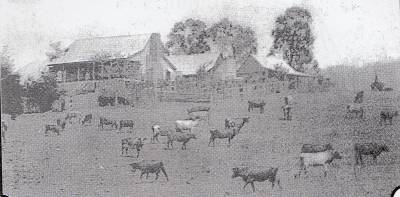 An undated photo of Rathdowney. The home has since been demolished and another rebuilt in its place. In September 1979, when it was inspected under the selection act, TLM-P was said to have lived in the weatherboard house with its single roof, a detached slab kitchen and separate slab house for workmen. There was also a garden.87)
An undated photo of Rathdowney. The home has since been demolished and another rebuilt in its place. In September 1979, when it was inspected under the selection act, TLM-P was said to have lived in the weatherboard house with its single roof, a detached slab kitchen and separate slab house for workmen. There was also a garden.87)
TLM-P's stockman John Worrall didn't just act as witness, but himself selected 320 acres to the north of the Rathdowney property. His two witnesses who swore that he had lived there permanently, and thus was entitled to own the land, were John Endersby (the other of TLM-P's employees/witnesses) and Thomas de M. M-P. In August 1879 when the selection process was completed, John Worrall immediately transferred the land to TLM-P.88)
By 1880, the local council's rate book valued Rathdowney's buildings at £3089) TLM-P sold Rathdowney in November 188490) to Willian Collins and Sons. Nora wrote to Rosa Pread that, if TLM-P were '20 years younger it would be madness to sell it yet the constant strain of hard labour is too much for him.'91) Rathdowney was subsequently subdivided and Rathdowney town developed there.92)
Land dealing and selections
TLM-P's land dealings were extensive and it is near impossible to follow them all. As shown above, he started to buy urban blocks in the 1850s.
The next table is by Angella Collyer who sourced it from the Queensland State Archives. It shows his land dealings in the 1860s.93)
| Lease 201 | 16 November 1868 | Portion No. 2 | Melcombe parish | 1,000 acres |
| Lease 202 | 16 November 1868 | Portion No. 3 | Melcombe parish | 890 acres |
| Lease 203 | 16 November 1868 | Portion No. 1 | Melcombe parish | 640 acres |
| Lease 371 | 2 June 1869 | Portion No. 5 | Telemon parish | 4,953 acres |
| Lease 3721 | 2 June 1869 | Portion No. 6 | Telemon parish | 4,910 acres |
| Lease 1129 | 8 September 1870 | Portion No. 4 | Melcombe parish | 674 acres |
| Lease 1506 | 19 April 1872 | Portion No. 13 | Palenn parish | 325 acres |
| Lease 1522 | 29 April 1872 | Portion No. 15 | Palenn parish | 1000 acres |
A total of 14,392 acres (5,824 hectares).
TLM-P's son also made numerous selections, see Thomas de Montmorenci, Florence and Mary M-P. TLM-P also had land in partnership with other family members, including his daughter Lizzie's husband Robert Jardine.
Angella Collyer also states that in 1867, TLM-P leased Melcombe (it had 60 square miles available for pasture improvement; 16 square miles unavailable; and a total of 100 square miles. “PP nil'.) and Heads Logan (20 square miles available; 16 square miles unavailable; total 36 square miles, PP nil.) In 1869 he consolidated the two as 'one large property of 100 square miles'94) then in 1874 he separated them again, calling one property of 54 square miles Melcombe/Maroon and the other Palen. It is unsure, she states, if Palen and heads of Logan had the same boundaries.95)
In the 1860s, with governments resuming land to break up into smaller farms, landowners such as TLM-P secured their (leased) land by buying it freehold. TLM-P had been 'freeholding [i.e. converting to freehold] parts of his run, including 2560 acres on 16 November 1868 alone. In 1876 he allowed what was left of the leasehold to lapse or revert to the government.' From then on, Maroon comprised entirely of freehold land.96)
As indicated, he manipulated the selection act. While he was sympathetic to the desire for people to own their own land, he was also aware that small holdings rarely provided a living for the selector. As he wrote in his 1888 diary: 'There seems to be a great land hunger. Now the more selections taken up the better but I can hardly see how they will make it pay - the labour and expenses of clearing is great; they deserve to succeed.'(entry for 5 July).
TO DO: the Beaudesert Museum has a number of holdings relating to the Murray-Prior family, see https://beaudesertmuseum.org.au/main/images/BEAUDESERT%20HISTORICAL%20MUSEUM.pdf
Murray Prior Range
This range of mountains, along with Mount Murray Prior, is in north Queensland, east of Cairns and near the indigenous community of Yarrabah. It was named after TLM-P.97)
LINK-BROKEN
==== Creallagh, Cleveland ==== Colin Roderick states that, after a year at Ormiston, in 1859 TLM-P moved to a mixed farm at nearby Cleveland, 'on the shores of Morton Bay, opposite Stradbroke Island. The farm was called Creallagh and grew maize, cotton and sugar-cane.((Roderick, In Mortal Bondage, p.32; The Australian Encyclopaediap.205